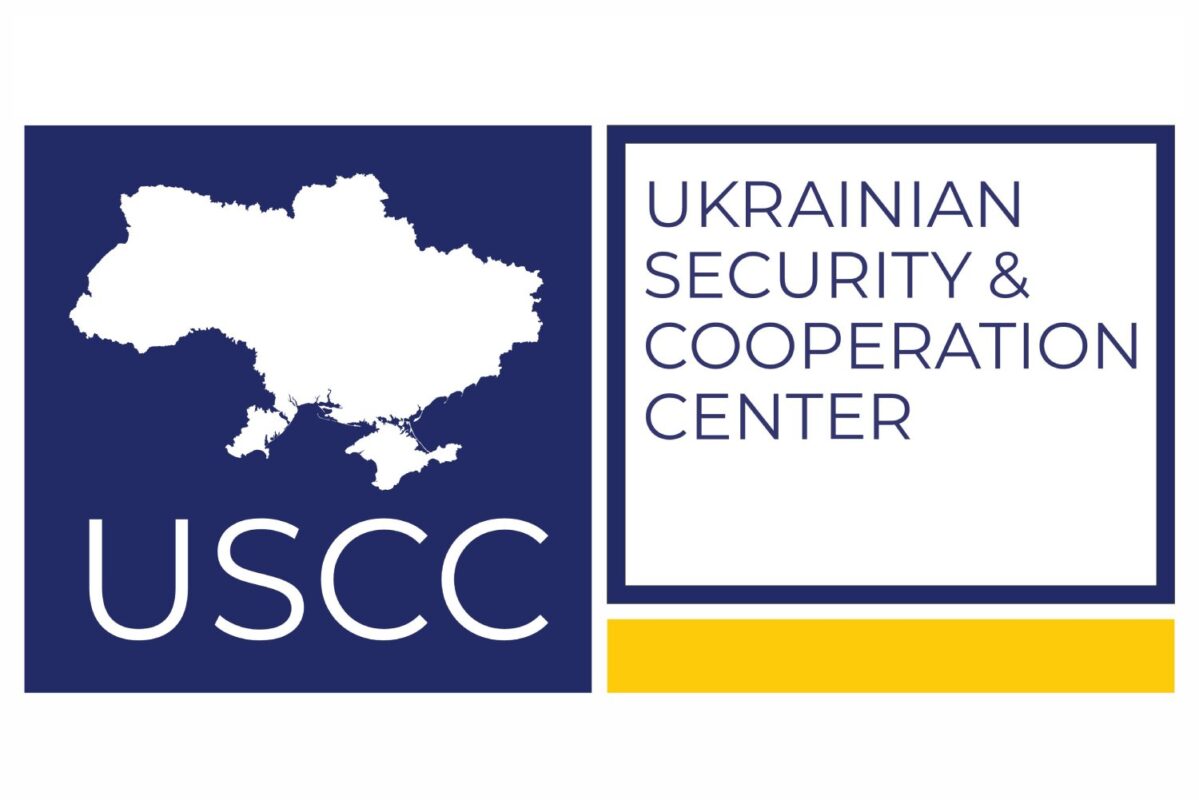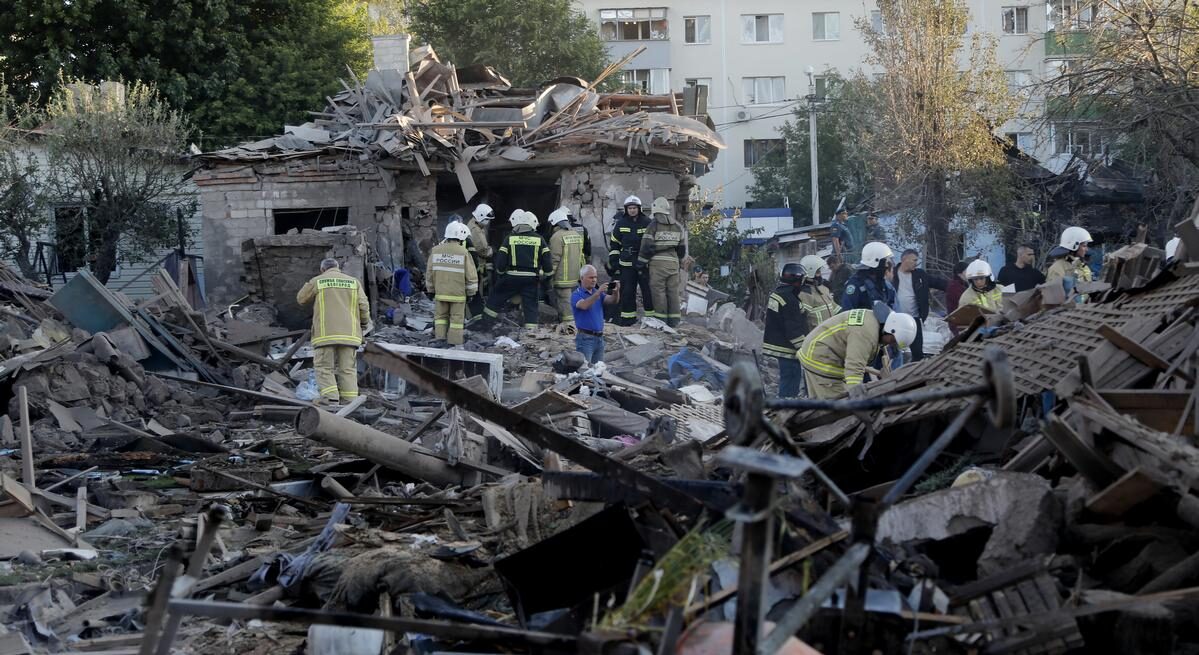The aftermath of the explosion in Belgorod. Source – BBC
Over the course of more than a year of full-scale invasion, the front lines in Chernihiv, Sumy, and Kharkiv regions were pushed back by Ukrainian military forces practically to the border with Russia. It was precisely during that time when the residents of Belgorod region and other bordering territories, who had been considering buying summer plots in Ukraine, fully experienced life under the “cotton explosions” and the actions of Russian volunteer battalion fighters, as well as the Kremlin’s actual “concern” for the “Russian-speaking population”.
WAR ON RUSSIAN TERRITORY
Ukraine’s defense of its lands against Russian forces is a long-term game. As a result of successful counteroffensive actions by the Armed Forces of Ukraine throughout the spring of 2022, the entire territory of Sumy region was liberated, and by September, Ukrainian Defense Forces had practically freed the entire territory of Kharkiv region from Russian forces.
These successful actions also allowed the Ukrainian side to deliver blows in response to the aggressor, conduct deep reconnaissance, engage in sabotage, drone attacks, and even raids by Russian volunteers into the enemy’s rear. The Ukrainian Defense Forces made its move: the war reached the territory of Russia itself. However, as expected, this topic is not a top priority in the Russian media or among the authorities, who continue to cling to the position that “everything is going according to the plan.”
FRONTIER CITY AND “GREAT RUSSIA”
The residents of the Russian border city of Belgorod, located just 72 km from Kharkiv, Ukraine’s second most populous city, probably vehemently disagree with the statement above. In pre-war times, Belgorod residents used to travel to Kharkiv for shopping and leisure. However, since February 23, rocket launches and salvo rocket fire from multiple launch rocket systems have regularly targeted Belgorod region, often causing damage to residential buildings and civilian deaths, typically with imprecise weaponry.
Based on Belgorod’s social media and press, the locals were mostly indifferent to this. This went on until the Ukrainian Armed Forces forced the occupiers to retreat, and Belgorod region became a frontline city with all the problems that entailed: refugees, shelling, saboteurs, and large number of military personnel and equipment. Additionally, detachments of Russians fighting on the Ukrainian side, such as the “Legion of Freedom of Russia” (LSR) and the “Russian Volunteer Corps” (RDC), began to raid the region.
The combination of these factors forced the local authorities to evacuate the population from border areas, allocate multimillion budgets for defensive structures, and start inspecting existing bomb shelters in the region. Some locals even criticized the shelling of Kharkiv to avoid retaliation or requested the authorities to “move the front line” away from the city.
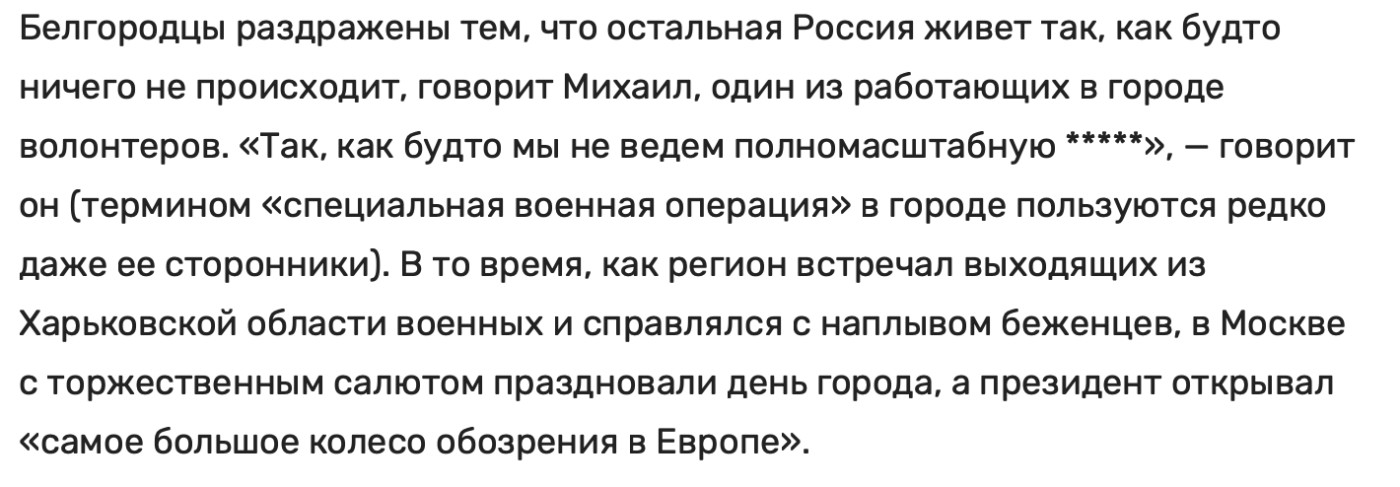
The residents of Belgorod are irritated that the rest of Russia is living as if nothing is happening, says Mikhail, one of the volunteers working in the city. “It’s as if we’re not in the midst of a full-scale ****,” he says (the term “special military operation” is rarely used in the city, even by its supporters). While the region met soldiers leaving the Kharkiv region and dealing with an influx of refugees, Moscow was celebrating its city day with triumphant fireworks, and the president was inaugurating “the largest observation wheel in Europe.”
Source – RTVI

“You have your holidays in Moscow. It’s sickening to watch. Here we are counting our last pennies to help [the refugees]…” he curses. “I’m sure that if [Ukrainian] troops come here, even in the Oryol region, people will act as if nothing is happening.”
Source – RTVI
Unfortunately, none of these statements have prompted the Russian government to end the aggressive war.
Official statistics from the Belgorod authorities indicate that there were over 6,500 refugees from border regions as of January 2023 (given that the Russian government conceals the consequences of the ongoing war, the actual figures could be much higher).
In the spring and summer of 2023, with the onset of raids by volunteers from LSR and RDC, the evacuation of the Shebekino district of Belgorod region only affected a minimum of 85,000 registered local residents, without considering other areas of the region and those who were living there without registration. At the same time, the authorities stated that they were ready to accept no more than 1,000 refugees in Belgorod itself, while others were offered to move to the Voronezh, Rostov, Tomsk, Yaroslavl, or Kaluga regions, which also announced their willingness to accept only a limited number of people. This triggered a wave of criticism from the locals.

Certainly, the assistance from fellow governors is very timely. Tomorrow, 200 individuals – mothers or grandmothers with small children – are leaving for the Penza region upon the invitation of Oleg Vladimirovich Melnichenko. On Saturday, 600 people – 300 from Gryazovets are going to the Yaroslavl region to Mikhail Yakovlevich Evraev, and 300 from Shebekino are heading to the Kaluga region to Vladislav Valeryevich Shapshe. – Listed by Gladkov.
Source – RTVI
Internal displacement has sparked numerous social media posts about the poor living conditions of refugees and issues with promised government pay-outs. A strong reaction was caused by providing free housing for residents from the occupied Ukrainian territories, especially from Kherson, whom the Kremlin attempted to resettle in Russia. Locals complained that no one needed Russians in Russia and that they got forgotten.
“Words can’t convey what it’s like to leave your home,” Russian media quote a pensioner from the border town of Shebekino. Experiencing what thousands of Ukrainians have gone through since 2014 and then from February 2023 hasn’t compelled Russians to demand an end to the war. According to a June 2023 survey by the Levada Center, the old generation who supports the war the most: 82% of them in Russia (down from 84% in April).

“It was terrifying, we barely managed to leave there.”
“We hid in the bathroom all night,” says Nadezhda, a pensioner from Shebekino. “They were bombing heavily, it’s impossible to put into words, we were trembling. Everything was shaking. My son came and said, ‘We’re being evacuated.’ There were armored vehicles on the square, and they took us to Belgorod.”
Words can’t convey what it was like to leave our home,” the woman continues, her voice breaking into tears. “We believe it’s not forever. We believe we’ll return home. We hope that very much. We heard that Ukrainian forces had broken through to the neighbouring village, that our guys were in combat.”
Source – news.ru
“With the beginning of the full-scale war, the world witnessed that the title of the ‘second army in the world’ is a very loud and contradictory definition of what the Russian armed forces represent. Marauding, exceptional cruelty towards prisoners, disregard for civilian lives, and numerous war crimes have become the hallmark of the Russian military and the entire so-called ‘special operation.'”
In addition to military activity and internal migration, Belgorod experienced all the “benefits” of the Russian military’s presence in the region. For instance, rockets launched from the region towards Ukrainian lands have repeatedly exploded within the region itself. A video published in a local Telegram channel in July 2022 captured a launch of “Iskander” missiles near a residential building, which failed to take off and fell to the ground.
Such incidents have become quite common for Belgorod: on August 31, a video emerged in local channels showing a rocket veering off course and flying low toward the city. On September 22, 2022, another rocket, likely from an “Iskander” system, crashed after launch. On October 13, 2022, during an attempt to shell Kharkiv, three Russian S-300 missiles self-destructed, with one hitting a residential building in Belgorod. And these are just the incidents where such unsuccessful launches have been shared online by locals. The Russian government has started to take internet censorship more seriously, and now posting such videos can lead to fines for discrediting the Russian armed forces.


The aftermath of a rocket fall in Belgorod. Source – Baza telegram.
Over time, incidents of failed bombings with more consequences became more frequent: on the evening of April 20, 2023, an explosion occurred on one of the central streets of Belgorod, creating a crater with a radius of 20 meters. After various versions from Russian military officials and likely due to the lack of casualties, the Russian Ministry of Defense eventually admitted that a bomb, likely an FAB-500-M62 high-explosive bomb, was accidentally dropped by a Russian Su-34 fighter jet. Within two days, the Belgorod authorities evacuated 17 residential buildings near the site, where another accidentally dropped Russian aerial bomb was found.


A sinkhole on one of the central streets of Belgorod. Source – Focus
In response to the barrage of criticism from residents about why combat aircraft, equipped with bombs, were flying over their own cities, propagandists began to offer counterclaims: “the bombs could have deviated from their course on their own,” “no one is flying over the city,” which even Russian experts found dubious.
TERRITORIAL DEFENSE ON ITS OWN TERMS
The “successes” of the Russian army in the war prompted the leadership of the border regions to consider defending their entrusted territories on their own. At the end of December, Governor Gladkov of Belgorod announced establishment of the territorial defense units to “protect our own home.” Symbolically, exactly a year before that, information about the establishment of Ukrainian territorial defense units in Russia was actively and scornfully discussed on social media and press.
According to official information, Belgorod’s territorial defense consists of about 3,000 individuals, and the local authorities are addressing the issue of their armament. Specifically, on August 2, some members of the territorial defense already got firearms, anti-drone rifles, and UAZ vehicles.
The region’s governor boasted that even schoolchildren are getting involved in military matters. “Now in Belgorod, Stary Oskol, Gubkin, Aleksiyevka, Valuyki, and Novy Oskol, there are military-sports centers ‘Warrior.’ The task is to cover all municipal entities of the Belgorod region by the end of the year. … I see the effect this has on children. They forget about their phones, engage in sapper activities, and work on UAVs,” stated Gladkov.

The matter of strengthening the defense of Belgorod region has also become a “hot topic.” In 2022 the region spent nearly 10 billion rubles on constructing fortification structures. According to information from the local portal fonar.tv, these expenses currently exceed the costs of building two infectious disease centers constructed in the region. These structures caused a wave of criticism and accusations of corruption towards the local authorities. In the end, neither the defensive line nor territorial defense in any way hindered the advance of volunteers from the RD Corps and the Legion towards the outskirts of Shebekino.
NUMBERS SAY: 28% OF RUSSIANS CONSIDER “SMO” UNSUCCESSFUL
One of the recent surveys, held by the Russian analytical center “Levada Center”, revealed interesting dynamic, likely connected to a series of events that impacted life on the Russian border regions. These events include the successful raids of Russian volunteers into the Belgorod region, the evacuation of locals, the Ukrainian Defense Forces’ counteroffensive, the supply of Western weaponry to Ukrainian forces, and internal conflicts within Russia, notably the “march” of Prigozhin (PMC Wagner) across Russia as a challenge to Russian authorities, which demonstrated Putin’s weakness.
According to the survey results, involving 1000 participants, overall support for the “special operation” decreased by 3% compared to May 2023.
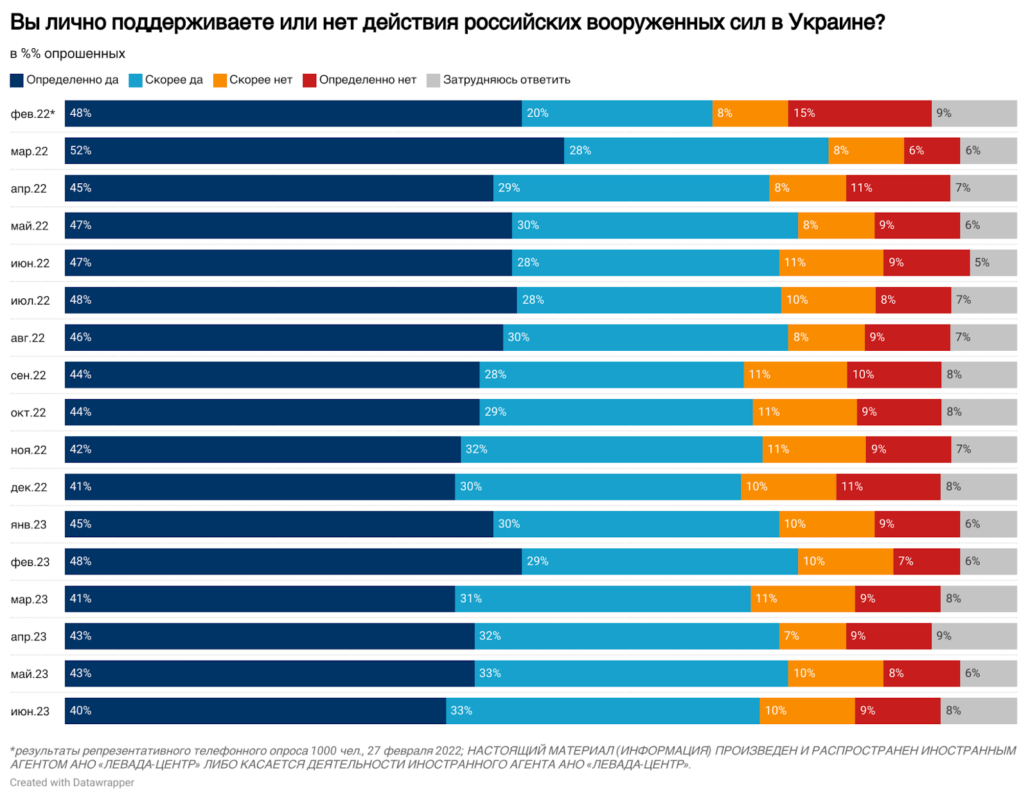
There’s a notable decline in the success ratings of the “special operation.” In May, 61% of respondents stated that the so-called “special operation” was proceeding successfully, but by June, only 55% of Russians held that opinion. Another 28% believe that the “special operation” is unsuccessful (consistent figures for both May and June), and accordingly, 12% were uncertain about their answer in May, increasing to 17% in June.
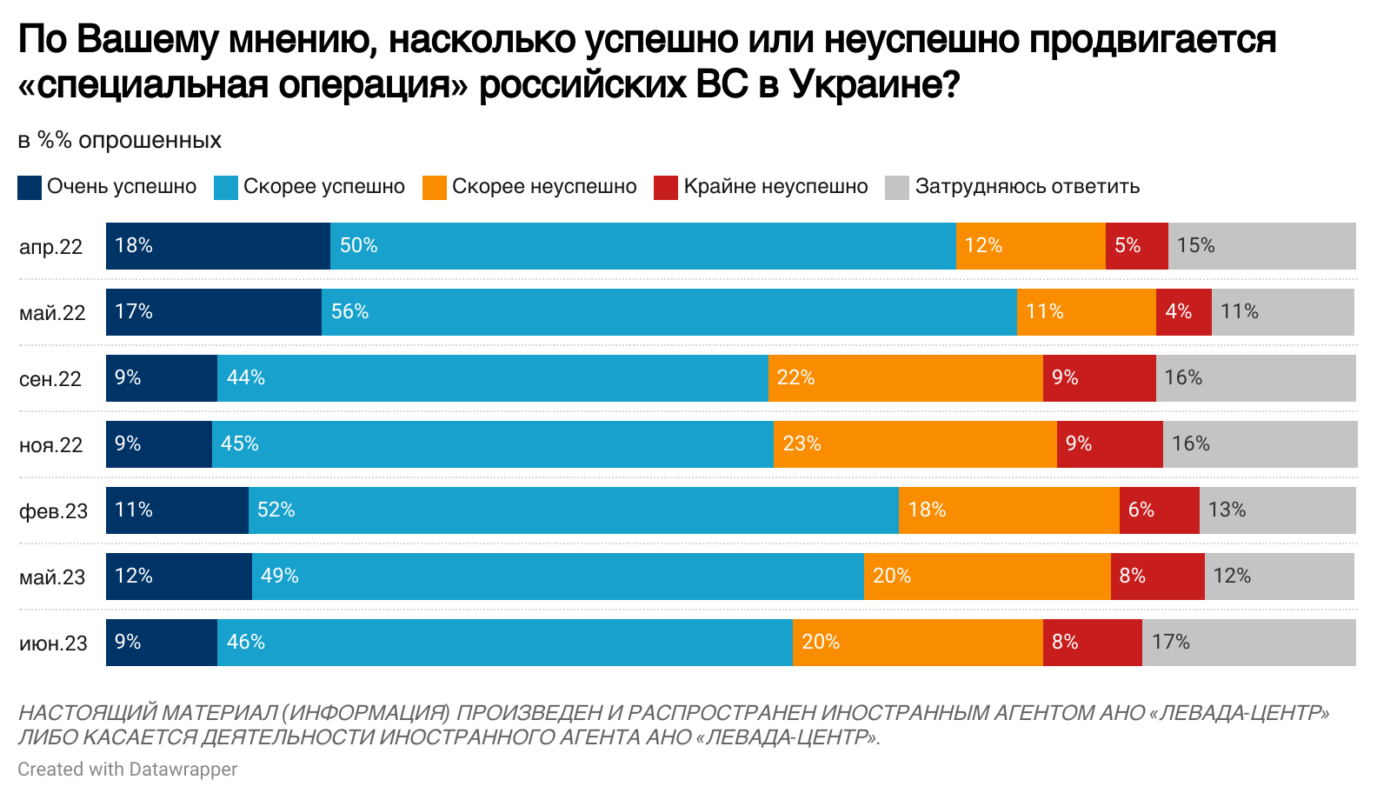
The overall number of those who believe that negotiations should be initiated with Ukraine has increased as well – 53% in June, compared to 46% in May. At the same time, 40% of respondents believe that the war should continue, a decrease from 48% in May.
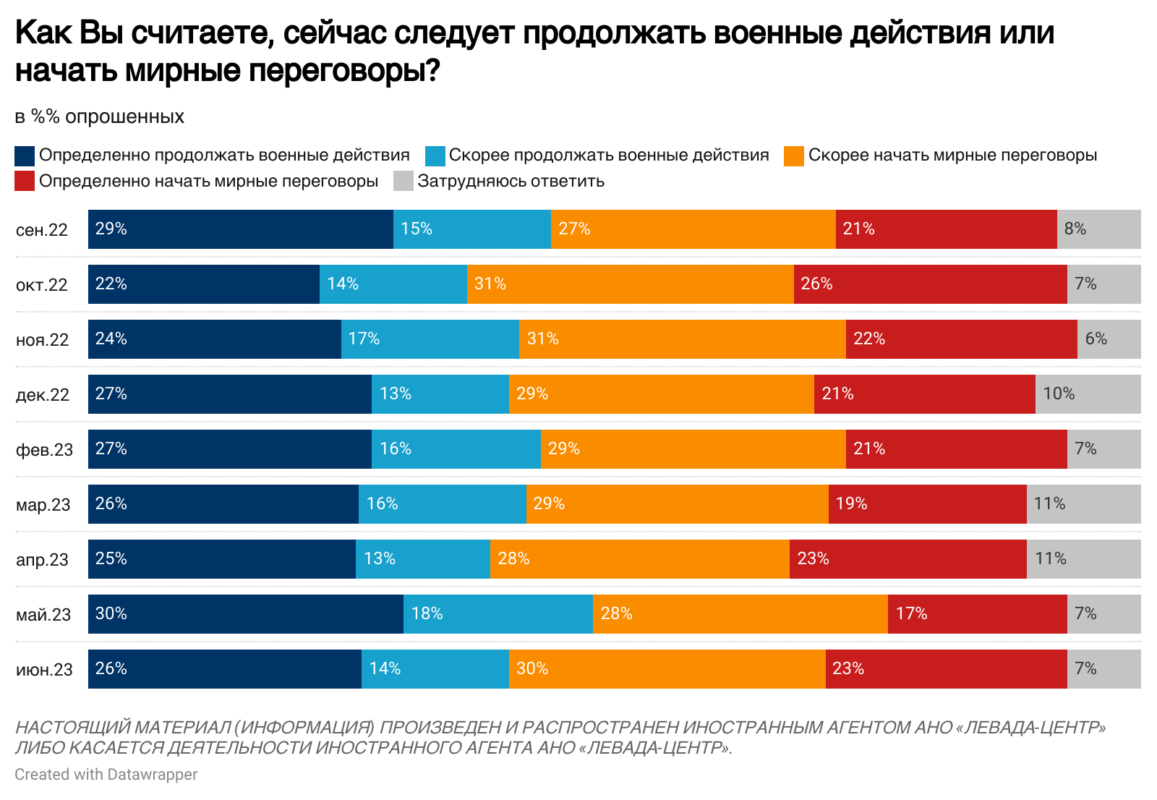
Responding to the question of what Russians are most concerned about in the “SMO” (special military operation), respondents answered as follows:
– 93% are concerned about drone and UAV attacks on Russian border territory.
– 93% are concerned about shelling of Russian border towns.
– 85% are concerned about the threat of nuclear weapon usage in the conflict.
– 80% are concerned about the supply of Western weaponry to Ukraine.
– 67% are concerned about the counteroffensive by the Ukrainian Armed Forces.
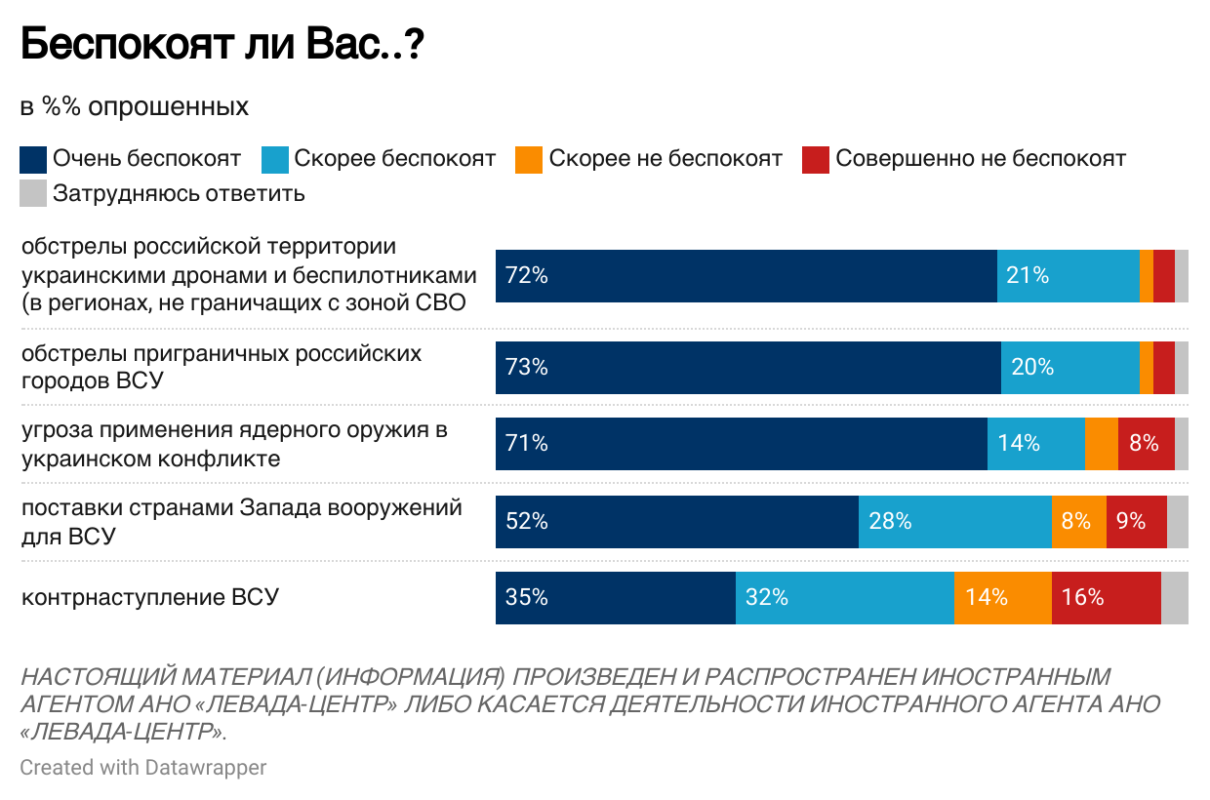
As always, it seems that Russians are mainly concerned by their issues and peaceful nights, while engaging in an aggressive war against another nation remains a routine for the majority of Russians.
Special attention should be paid to the reports from Russian central media regarding the shelling of Russian border regions, where the Ukrainian Armed Forces are referred to as “terrorists” or “Ukrainian Nazis” instead of opponents or enemies. These reports become particularly infuriating when infrastructure or civilian objects are affected during attacks. After all the civilian casualties, including the deaths of children and women, thousands of destroyed buildings in Ukrainian cities, towns wiped off the face of the earth in Donbas, and dozens of flooded villages, the cynicism of these headlines reaches extreme levels.


“Ukrainian terrorists were shelling the border of Belgorod region all day”
Source – IA Regnum ta First Channel
NOT UNDER THE PLAN
In conclusion of the analysis of the situation in Belgorod Oblast, we can highlight the following points:
Overshadowed by Putin’s dreams of “Kyiv in 3 days,” the Russian government did not anticipate nor plan that they would have to defend their own border territories. The issues with Russian refugees and their problems are rarely addressed by the Kremlin, being an uncomfortable discussion point, as they don’t fit into the narrative of the “victorious Special Operation,” while locals from Belgorod continue to relocate.
The authorities of Belgorod region were also unprepared for the influx of refugees from their own territories and the failures of the Russian military. Currently, they are attempting to maintain the appearance of normalcy, avoid panic, and suppress discontent with the consequences of the “special operation” in other regions of Russia.
The Russian military typically hides behind civilians during shelling, as seen in Donetsk and Luhansk, but now their own citizens are being used as a “living shield.” Residents of Shebekino in Belgorod have personally experienced the effects of Putin’s declared “special operation” (as well as the “strength” of Russian defense) and the actual attitude of the government towards the problems of ordinary people.
The combination of factors such as: the influx of volunteers to Belgorod region, the activity of Ukrainian drones on Russian territory, the Ukrainian Armed Forces’ counteroffensive, the lack of significant successes in the context of a prolonged war, and further deliveries of Western weaponry impacted Russians’ mood, their mobilization capacity, and ongoing support to conduct a full-scale war.
